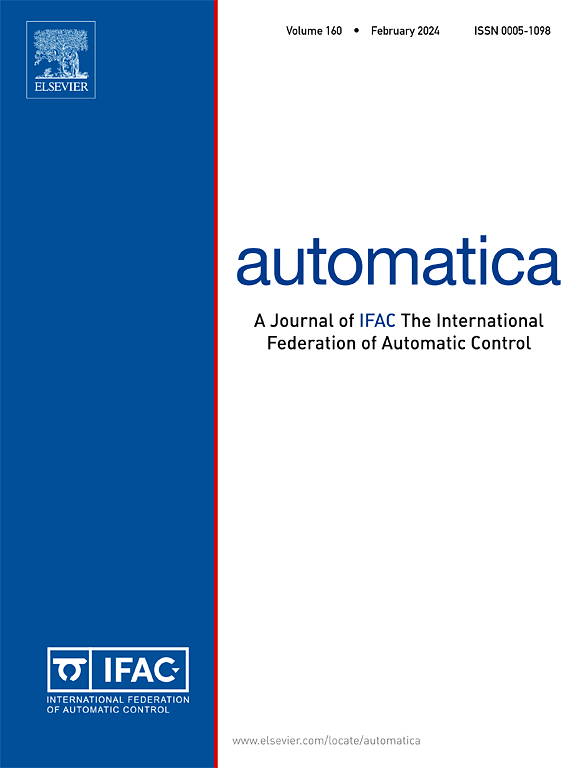Continuous-time successive convexification for constrained trajectory optimization
IF 5.9
2区 计算机科学
Q1 AUTOMATION & CONTROL SYSTEMS
引用次数: 0
Abstract
We present continuous-time successive convexification (ct- scvx ), a real-time-capable solution method for constrained trajectory optimization, with continuous-time constraint satisfaction and guaranteed convergence. The proposed solution framework only relies on first-order information, and it combines several key methods to solve a large class of nonlinear optimal control problems: (i) exterior penalty-based reformulation of the path constraints; (ii) generalized time-dilation; (iii) multiple-shooting discretization; (iv) -exact penalization of the nonconvex constraints; and (v) the prox-linear method, a sequential convex programming (SCP) algorithm for convex-composite minimization. The proposed reformulation of the path constraints enables continuous-time constraint satisfaction even on sparse temporal discretization grids and obviates the need for mesh-refinement heuristics. Through the prox-linear method, we guarantee that: (i) ct-scvx converges to stationary points of the penalized problem; (ii) the converged stationary points that are feasible for the discretized and control-parameterized optimal control problem are also Karush–Kuhn–Tucker (KKT) points. Furthermore, we specialize this property to global minimizers of convex optimal control problems and obtain stronger convergence results by exploiting convexity. In addition to theoretical analysis, we demonstrate the effectiveness and real-time performance of ct-scvx by means of numerical examples from real-world optimal control applications: dynamic obstacle avoidance, and 3-degree-of-freedom (3-DoF) and 6-DoF autonomous rocket landing.
约束轨迹优化的连续时间连续凸化
提出了连续时间连续凸化(ct- scvx)方法,这是一种能够实时求解约束轨迹优化问题的方法,具有连续时间约束满足和保证收敛性。所提出的求解框架仅依赖于一阶信息,它结合了几种关键方法来解决一类非线性最优控制问题:(1)基于外部惩罚的路径约束的重新表述;广义时间膨胀;(iii)多次射击离散化;(iv)非凸约束的1-精确惩罚;(v) prox-linear方法,一种求解凸复合最小化的序列凸规划(SCP)算法。提出的路径约束的重新表述使得即使在稀疏的时间离散网格上也能满足连续时间约束,并且避免了对网格优化启发式的需要。通过近线性方法,我们保证:(i) ct-scvx收敛于惩罚问题的平稳点;(ii)对于离散化和控制参数化的最优控制问题可行的收敛平稳点也是KKT点。进一步,我们将这一性质专门应用于凸最优控制问题的全局极小性,并利用凸性得到了更强的收敛结果。除了理论分析之外,我们还通过现实世界最优控制应用的数值例子证明了ct-scvx的有效性和实时性:动态避障,3自由度(3-DoF)和6自由度自主火箭着陆。
本文章由计算机程序翻译,如有差异,请以英文原文为准。
求助全文
约1分钟内获得全文
求助全文
来源期刊

Automatica
工程技术-工程:电子与电气
CiteScore
10.70
自引率
7.80%
发文量
617
审稿时长
5 months
期刊介绍:
Automatica is a leading archival publication in the field of systems and control. The field encompasses today a broad set of areas and topics, and is thriving not only within itself but also in terms of its impact on other fields, such as communications, computers, biology, energy and economics. Since its inception in 1963, Automatica has kept abreast with the evolution of the field over the years, and has emerged as a leading publication driving the trends in the field.
After being founded in 1963, Automatica became a journal of the International Federation of Automatic Control (IFAC) in 1969. It features a characteristic blend of theoretical and applied papers of archival, lasting value, reporting cutting edge research results by authors across the globe. It features articles in distinct categories, including regular, brief and survey papers, technical communiqués, correspondence items, as well as reviews on published books of interest to the readership. It occasionally publishes special issues on emerging new topics or established mature topics of interest to a broad audience.
Automatica solicits original high-quality contributions in all the categories listed above, and in all areas of systems and control interpreted in a broad sense and evolving constantly. They may be submitted directly to a subject editor or to the Editor-in-Chief if not sure about the subject area. Editorial procedures in place assure careful, fair, and prompt handling of all submitted articles. Accepted papers appear in the journal in the shortest time feasible given production time constraints.
 求助内容:
求助内容: 应助结果提醒方式:
应助结果提醒方式:


